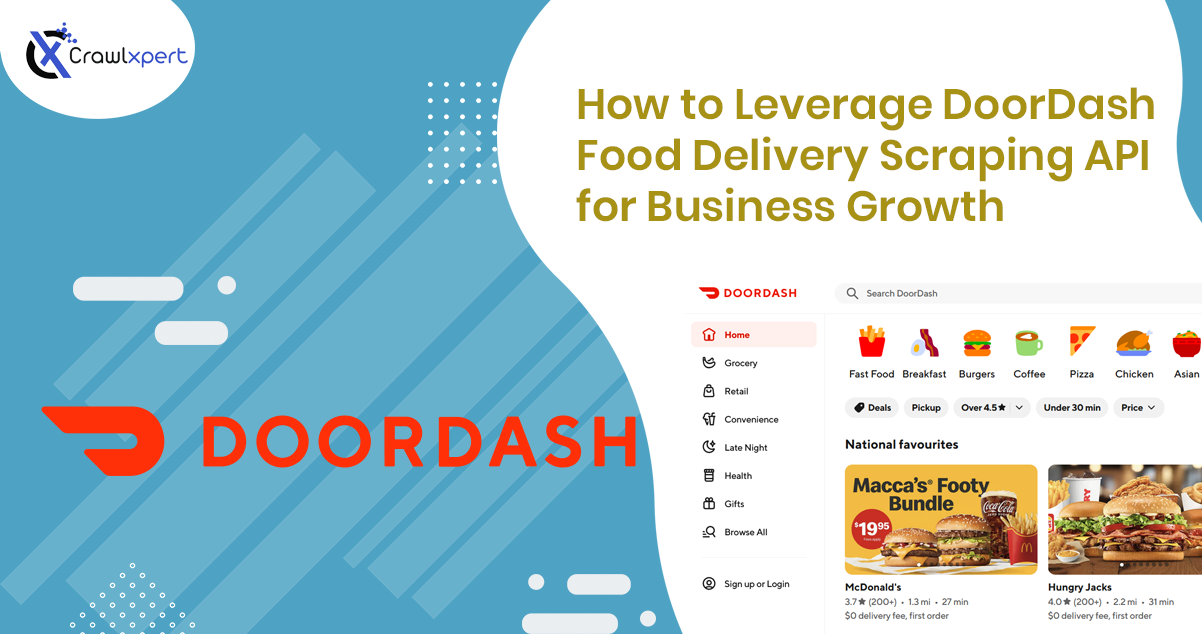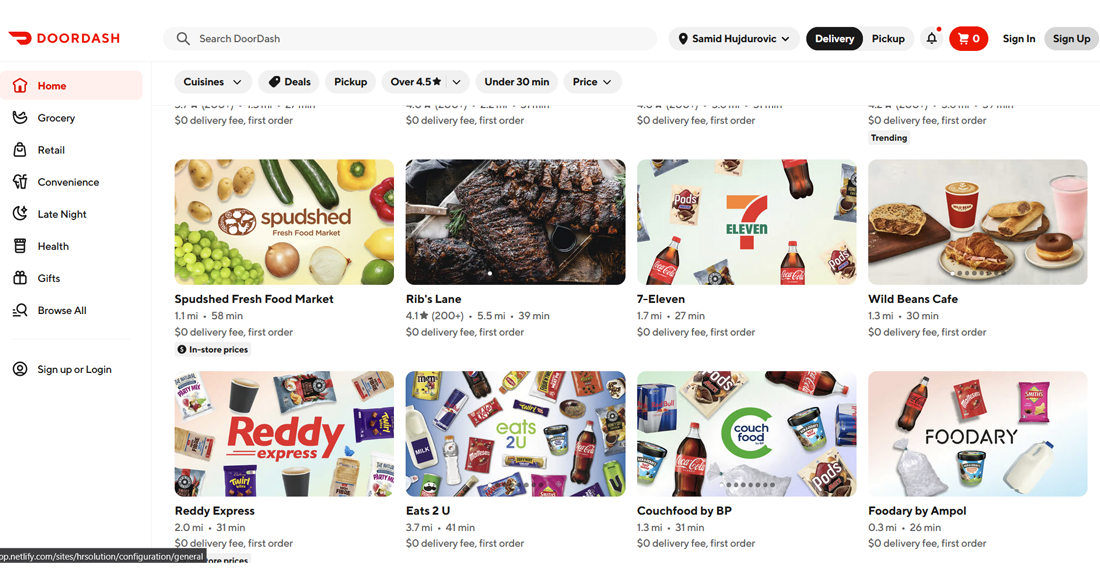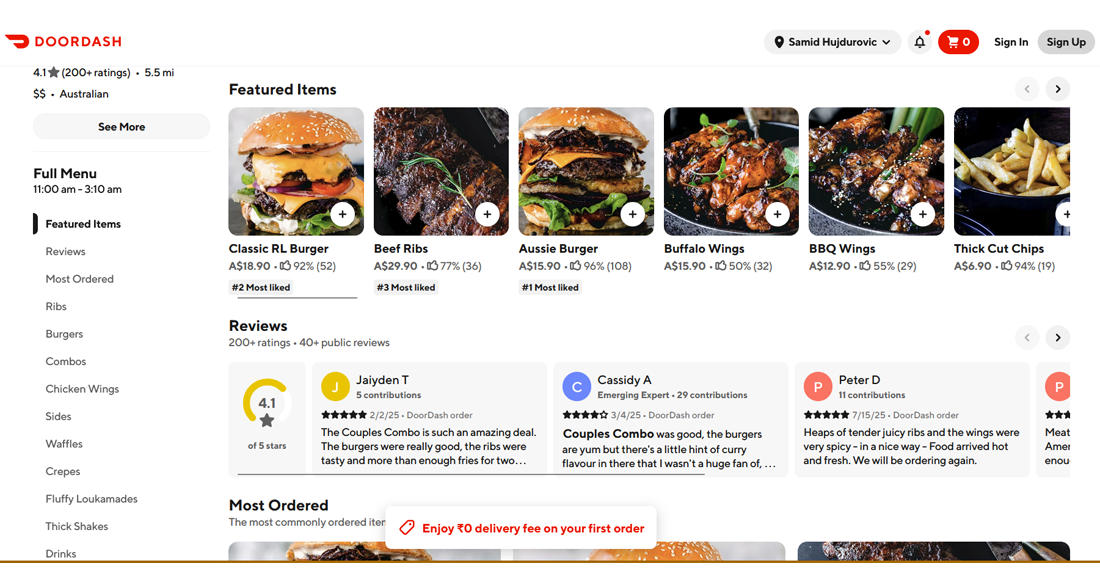
How to Leverage DoorDash Food Delivery Scraping API for Business Growth
Published on September 26, 2025
Introduction
As online food delivery platforms rapidly reshape consumer dining habits, DoorDash has become a dominant force in the U.S. and beyond. With over 500,000 partnering restaurants, DoorDash captures a wealth of market, pricing, and behavioral data—an invaluable goldmine for data-driven businesses, food brands, cloud kitchens, and analytics firms.
This blog explores how to leverage DoorDash data using scraping APIs, reverse-engineering techniques, and automation to generate powerful insights for business growth.
We'll walk you through:
- Why DoorDash data matters
- What kind of data can be extracted?
- How to implement scraping (ethically and efficiently)
- How to turn data into actionable strategies

1. Why Scrape DoorDash Data?
DoorDash delivers more than food—it delivers competitive intelligence. Here's why scraping its platform offers strategic value:
1.1 Market Insights
- Discover popular cuisines by city or neighborhood
- Identify trending restaurants and newly launched vendors
- Spot food delivery behavior patterns (meal times, discounts)
1.2 Competitor Analysis
- Compare pricing, delivery charges, and discounts
- Track menu updates and availability across locations
- Benchmark performance across vendors in your segment
1.3 Geo-Targeted Strategy
- Map vendor density by ZIP code
- Detect underserved regions for cloud kitchens
- Align supply chain and inventory to local demand
1.4 Data for AI/ML
- Train models to predict delivery demand
- Personalize food recommendation systems
- Analyze user preferences and seasonal patterns

2. Types of Data You Can Extract from DoorDash
While DoorDash doesn’t offer a public API, its web application architecture uses JavaScript-based API calls, which can be intercepted and reverse-engineered.
Vendor and Menu Listings
- Restaurant name
- Cuisine types
- Operating hours
- Menu items, combos, and customization
- Pricing (including delivery and tax)
Location Metadata
- Store location (lat/long, ZIP code)
- Delivery zones
- Estimated wait and delivery times
Promotions & Offers
- Featured vendor banners
- Promo codes
- Discounts (flat, percentage, BOGO)
Reviews & Ratings
- Star ratings
- Total number of reviews
- Recent review keywords
3. Tools You Need for DoorDash Data Scraping
| Tool/Library | Purpose |
|---|---|
| Python | Scripting language |
| Requests | Handle direct API calls |
| Selenium | For JS-rendered pages |
| BeautifulSoup | Parse HTML (if needed) |
| Pandas | Organize and export data |
| GeoPy or OpenCage | Convert ZIP codes to coordinates |
| Plotly / Tableau | Visualize insights |
4. Exploring the DoorDash Web API (Unofficial)
Step 1: Open DevTools → Network Tab
Visit https://www.doordash.com, enter a ZIP
code, and observe the API calls while browsing vendors.
Look for calls like:
https://consumer-api.doordash.com/v1/store_search/...These return JSON responses with hundreds of restaurant listings and metadata.
5. Sample Python Script to Scrape Vendor Listings
Let’s reverse engineer a ZIP-based search:
import requests
import pandas as pd
headers = {
"User-Agent": "Mozilla/5.0",
"Content-Type": "application/json",
}
params = {
"lat": 37.7749,
"lng": -122.4194, # San Francisco
"limit": 50,
"offset": 0
}
url = "https://consumer-api.doordash.com/v1/store_search/"
response = requests.get(url, headers=headers, params=params)
results = response.json()
vendors = []
for store in results.get('stores', []):
vendors.append({
"Name": store.get("name"),
"Description": store.get("description"),
"Rating": store.get("average_rating"),
"Num Reviews": store.get("number_of_ratings"),
"Delivery Time": store.get("fulfillment_time"),
"Address": store.get("address", {}).get("printable_address")
})
df = pd.DataFrame(vendors)
df.to_csv("doordash_sanfran.csv", index=False)You can now repeat this across ZIP codes or cities.
6. Key Use Cases of DoorDash Scraped Data for Growth
6.1 Geographic Expansion Strategy
Use location data to:
- Identify areas with high vendor density (high competition)
- Spot ZIP codes with few options (high opportunity)
- Guide cloud kitchen placement or local partnerships
6.2 Dynamic Pricing Benchmarking
- Adjust your own pricing or combos
- Monitor inflationary trends by cuisine
- Optimize price points by neighborhood demographics
6.3 Market Research & Product Launch
- Test new menu items against local preferences
- Monitor emerging food categories (vegan, keto, ethnic)
- Use vendor review sentiment to understand customer pain points
6.4 Hyper-Personalized Ads & Promotions
Combine:
- Cuisine trends
- Location-based favorites
- Delivery time ratings
...to create:
- Geo-targeted promotions
- Flash offers during peak times
- Personalized SMS/email campaigns
6.5 Feeding Your Data Pipelines (AI/ML)
- Predictive order surges by hour
- Popularity scoring of cuisines
- Optimal delivery time forecasting
- Automated rating-based vendor ranking
7. Visualizing Insights: Example Dashboards
After collecting data, plug it into visualization tools like Tableau, Power BI, or Plotly to create:
| Dashboard Type | Purpose |
|---|---|
| Heatmap of vendor density | Optimize delivery zones |
| Price vs. Rating scatter | Correlate value to quality perception |
| Cuisine trend timeline | Spot seasonal or monthly shifts |
| Review sentiment histogram | Track feedback evolution per category |
8. Challenges in Scraping DoorDash
| Challenge | Recommended Fix |
|---|---|
| JavaScript rendering | Use Selenium or Puppeteer |
| IP throttling or rate limits | Use delay + proxy rotation |
| Data inconsistency | Normalize categories and names |
| Geo-coding issues | Use clean ZIP to Lat/Long conversions |
9. Legal and Ethical Considerations
Scraping DoorDash data—especially at scale—must be done responsibly and in compliance with:
- DoorDash’s Terms of Service
- The site's robots.txt (limit HTML scraping accordingly)
- Applicable data privacy laws (GDPR, CCPA if handling PII)
You should:
- Use scraped data for internal insights, not for resale
- Avoid collecting or exposing customer data
- Ensure scraping is rate-limited and respectful
10. Final Thoughts: DoorDash Data = Delivery Intelligence
Food delivery platforms like DoorDash are more than just ordering tools—they’re real-time windows into consumer demand, local cuisine economics, and competitive activity.
With scraping and automation, you can:
- Benchmark competition
- Guide expansion into delivery-dense neighborhoods
- Personalize campaigns
- Feed powerful AI models
- Increase your speed-to-insight ratio
If you’re in food tech, Q-commerce, restaurant management, or even venture analysis, this is the kind of data that makes a real business impact.
Route Example
Route::get('/web-scraping-holiday-deals-for-tracking-prices', function () {
return view('pages.blogs.web-scraping-holiday-deals-for-tracking-prices');
})->name('web-scraping-holiday-deals-for-tracking-prices');
